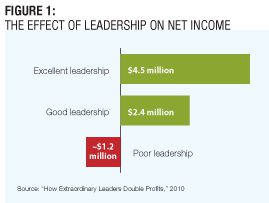More than ever, organizations recognize the value of good leadership. According to the Corporate Leadership Council, organizations with high-quality leadership outperform their competitors in shareholder returns and market capitalization, whereas poor leadership is related to an average of $1.2 million in net losses (Figure 1).

There is an acronym that sums up the post-recession economy: VUCA — volatile, uncertain, complex and ambiguous. Coined by the U.S. Army War College, VUCA is the new normal — leaders encounter unanticipated, novel and complex situations for which they have little experience. In the world of global credit crises, budget cuts and massive changes in consumer spending, simulations can help learning leaders effectively and efficiently prepare leaders to navigate a VUCA world.
Who Needs the Real Thing?
Much as flight simulators teach pilots how to manage life and death situations without paying the ultimate price, some leadership lessons should not be learned on the job. “Flight simulators put you in situations you hope that you will never encounter in the aircraft,” said Mark Gasta, chief people officer of Vail Resorts and a former commissioned officer and pilot in the U.S. Army. “In doing so, they give you the confidence that with the proper training and preparation you can overcome almost any situation.”
For example, a leadership simulation allows participants to practice skills such as disaster response, managing a difficult product launch, losing a key customer or navigating a financial slump. In a virtual simulator, a candidate might lead a fictitious organization for three hours. The candidate is bombarded with emails, telephone calls or online meetings with fictitious co-workers, prepares and presents a strategic plan to a board, coaches a resistant superstar, conducts damage control for a product launch or makes statements for the media about a corporate social responsibility issue. All role-plays are live and conducted with trained actors, and the constant stream of emails mirrors a leader’s everyday life.
Further, simulations are more effective at predicting performance and leadership potential than interviews or situational judgment tests. A 2011 study by PDI Ninth House, a leadership consultant, showed that simulation ratings had stronger relationships with on-the-job performance than more traditional methods. Candidates scoring in the top 25 percent also were four times more likely to be high performers.
Today, the term simulation includes everything from simple classroom role-plays to day-in-the-life assessment centers. As applied in organizations, however, simulations differ on many dimensions such as purpose, cost, skills assessed and level of realism. For example, behavioral measurement by trained observers is characteristic of assessment center simulations and is particularly useful to identify leaders’ strengths and development needs in the VUCA world (Figure 2).

When organizations prefer to avoid real consequences of leaders’ failure, either virtual or day-in-the-life simulations where participants assume a role in a fictitious company may be appropriate. Until recently, these simulations were generally reserved for large corporations that could afford the design and administration costs. In 2005, reported design costs were as high as $500,000 and $9,000 per participant, according to the Corporate Leadership Council. Today organizations have access to cost-effective virtual simulators that run around $1,500 per leader.
In addition to avoiding the cost of failure, other benefits include reduced design costs, eliminated facilities and travel costs, easier deployment, global reach, and rapid customization of content and report format. Virtual simulators, which often last a few hours and are administered through email, phone calls and online meetings, may best mimic business interactions in today’s technology-rich workplace.
Boosting the Real With the Fake
Baxa Corp., a medical technologies provider, employs a combination of virtual simulators and on-the-job assignments in its high potential program. “Cost is the biggest differentiator for small and mid-sized companies,” said Susan Starkey, Baxa’s organizational development manager. “They often go with a 360 or personality test instead of a simulation. But 360s can be painful, especially for early leaders. Simulations offer a fun alternative to discover strengths and development needs.”
Julie Bellamy, vice president of human resources at PKC Group, a global wiring systems and electronics provider, said, “We are a small ‘large’ company that needs flexible and cost-effective talent development solutions. The new virtual assessments allowed us to pilot a program within one month, test it to ensure it provided the information we thought it would and to craft our assessment program while we piloted it. It was a huge leap for many of our leaders, especially those outside the U.S., but it proved highly valuable from both the company’s and the participants’ perspectives.”
Simulations add value in several leadership development areas: exposure to a VUCA world, preview of a particular leadership role, opportunity to practice skills, and assessment of leaders’ strengths and development needs. Because of their ability to predict job performance, simulations increase leaders’ awareness of their own skills and gaps. The fine-grained behavioral feedback resulting from careful observations can enhance development planning, as the leaders’ knowledge of specific behaviors needed to be effective increases. For instance, research by Global Assessor Pool, a leadership consultancy, showed that simulation feedback helped 80 percent of high-potential leaders better understand their strengths and development needs (Editor’s note: One of the authors works for Global Assessor Pool). In comparison, a personality test increased similar understanding of only 20 percent of high-potential leaders.
The CLO can apply simulations to existing leadership development programs to enhance participant engagement and strength of behavior change through two approaches: using simulations to increase leader awareness of strengths and development areas, and using simulations to focus on-the-job learning.
Approach No. 1: Simulation feedback enhances awareness of strengths and development areas. Many complex simulation programs end with a feedback report. Some suggest much of the learning actually happens during the simulation debrief, when leaders reflect on the simulation events, relate them to assessed competencies, discuss mistakes, generate alternative approaches and discuss links between the simulation and their jobs.
At PKC Group, a group debrief has three steps post-simulation. First, leaders in debrief groups share their personal reactions to the questions, “How did the simulation go for you? What were your most and least favorite parts? What emotions did you experience?” Second, the group members discuss the simulation and application to their jobs: “What decisions were you asked to make? What objectives were you able to achieve? What knowledge and skills did you use? How is this simulation connected to your current or future job?” Third, the debrief catalyzes individual reflection and summary, with leaders completing a structured reflection sheet for learning and take-home messages.
Approach No. 2: Simulations focus and enhance stretch assignments. For most adult learners, reflection enhances learning. But for developing leaders, reflection may not always be enough to generate behavior change. Leveraging on-the-job stretch assignments post-simulation can take learning to a whole new level.
For example, Vail Resorts has participants in its leadership development curriculum go to the local mall to learn how to hunt trends and spot innovation in unlikely places. They are then challenged to integrate this information into new services and products, which they pitch to peers and executives. In these simulations, candid feedback is a priority, and the experience is as important as the end product.
“Doing ‘the coolest thing’ in talent management is part of our brand,” Gasta said. “Our culture is ‘don’t preach to me.’ When I bring an experiential piece, people are engaged immediately. So we incorporate experience in all leadership development programs, but it can’t be fake. The more [it is] realistic, the better.”
At Baxa, after participants practice in the safety of the virtual simulator and discover their strengths and development needs, they extend the experience through on-the-job assignments specifically targeting the individual’s development. Leaders’ supervisors are closely involved in identifying an appropriate stretch assignment, and external coaches ensure accountability.
Nelnet, an education planning and financing organization, also applies simulations to enhance on-the-job learning. “Our leaders form small ventures, get seed funding, mentoring from our executives, and have six to 12 months to become profitable,” said Evan Roth, Nelnet’s chief learning officer. “Some make it and become a new unit within our company; for other ventures it’s game over.”
Aligning the simulation to an on-the-job assignment can be challenging, as the assignment must stretch particular skills in the leader while balancing potential costs of the project’s failure for the organization (Figure 3, page 33). Behavioral observations from the simulation highlight the specific behaviors the leader should practice. For example, if a high-potential leader demonstrates a lack of financial acumen in a simulation, and that knowledge is necessary in his or her future career path, CLOs might design an on-the-job assignment to include some element of finance, such as creating a business plan, a capital proposal or business case.
Simulations have a long history with countless success stories in organizations such as Vail Resorts, Baxa Corp., PKC Group and Nelnet. They allow leaders to safely experience a VUCA world, enhance their insight, focus their development, instigate reflection and target on-the-job assignments. Although simulations have traditionally been confined to multimillion-dollar corporations, today’s technology-enabled simulations can be used by any organization. Indeed, simulations may no longer be the best-kept secret in leadership development.
Martin Lanik is founder and president of Global Assessor Pool, a multinational leadership consultancy. Tasha L. Eurich is principal of The Eurich Group, a leadership and team development consultancy. They can be reached at editor@CLOmedia.com.















